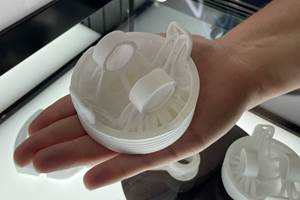Researchers Lay Groundwork for 3D Printing Electrical Machines
For more than a year, three partners have been focused on a research project that lays the groundwork for next-level electrical machines as they work to gain an in-depth understanding of the involved materials and technologies.
Share
Read Next

The research team says the design of crucial motor parts has a thorough impact on how the electrical currents interact with the magnetic field to create torque. Photo Credit: Ghent University
Additive Manufacturing for Electrical Machines (AM4EM) is a research project by Ghent University, KU Leuven and VITO for the application of 3D printing or additive manufacturing (AM) to improve the performance of electrical machines. The aim is to achieve more energy-efficient electrical motors such as stator or rotor cores.
Their focus is to imagine the perfect motor combining the best insulating and conductive materials in the best possible design — where the impact of the current is optimally converted into actual movement. The main challenge is to combine these conductive and insulating materials into complex multimaterial geometries. Researchers say this is a challenge because multimaterial 3D printing is basically still in its infancy. Hence, all materials, printing technologies and designs have to be thoroughly evaluated.
VITO is an independent research organization in the area of clean technology and sustainable development. More specifically, it has been researching 3D printing viscous powder-loaded pastes, which it says is an underexposed segment in AM. This paste printing with ceramics and metals is one of the technologies used in the project. The team says some important steps have already been realized. Micro-extrusion 3D printing of copper paste has led to printed parts without printing defects, a relative density of 95-99% and an electrical conductivity of 90-102% IACS. Researchers say this means it is possible to print pure copper with the properties needed for the applications at hand.
Positive results have also been achieved with the 3D printing of Fe-Si steel, which is needed for the motor core. The next step is to print multimaterial combinations for the magnetic core stacks, whereby a layer of ceramic insulator alternates with Fe-Si steel layers. Although initial results look positive, there are still related challenges such as uniform shrinkage of the material and warping of the layers.
KU Leuven is known in AM as the cradle of Materialise and Layerwise (now 3D Systems). In this project, it is focusing on fused filament fabrication (FFF) of metals and ceramics. Or rather it prints polymer filaments with a high content of metal or ceramic powder. The polymer in the filament is only needed to make the material printable and is removed after printing. Here, the challenge is only partially related to the 3D printing itself — debinding and sintering require careful analysis as well to determine the optimal parameters such as temperatures, solvents, extrusion width or speeds and more. KU Leuven’s efforts have resulted in relative density results above 95% for copper and 97.3% for ceramic, and even for combinations of both materials in one print.
Ghent University has expertise in multiphysics models for electrical machines and is focused on the complexity of how currents actually flow through conducting materials, which requires in-depth simulation expertise. This is because the design of crucial motor parts has a thorough impact on how the electrical currents interact with the magnetic field to create torque. By consequence, the design details strongly determine how efficient the machine will ultimately be. Researchers says these smart designs can make quite a difference when it comes to the efficiency of the resulting magnetic flux.
These combined efforts on different printing techniques, design and material improvements may deliver innovative MM-AM processes that can be applied for sensors, radars, actuators, electrical machines and more. Ultimately, the AM4EM project targets an increase in energy efficiency by 5% (compared to small induction machines) and an increase in power density by 40%. The team says the fundamental research and development steps taken in the AM4EM project are essential in order to decrease the energy consumption of our society as a whole.
Related Content
3D Printing Brings New Possibilities for Manufacturing With Ceramics: AM Radio #27A
AM expands the opportunities for ceramics. On the AM Radio podcast, a discussion of various 3D printing processes making use of ceramic material, and various new applications for ceramics that are developing as a result.
Read More8 Cool Parts From RAPID+TCT 2022: The Cool Parts Show #46
AM parts for applications from automotive to aircraft to furniture, in materials including ceramic, foam, metal and copper-coated polymer.
Read MoreSafer Nuclear Energy: 3D Printed Silicon Carbide Fuel Forms
Binder jetting provides a way to create pure silicon carbide fuel structures that can withstand the harsh environment of a nuclear reactor and provide a strong barrier against the release of radionuclides.
Read More8 Cool Parts From Formnext 2023: The Cool Parts Show #65
New additive manufacturing technologies on display at Formnext were in many cases producing notable end-use components. Here are some of the coolest parts we found at this year’s show.
Read MoreRead Next
At General Atomics, Do Unmanned Aerial Systems Reveal the Future of Aircraft Manufacturing?
The maker of the Predator and SkyGuardian remote aircraft can implement additive manufacturing more rapidly and widely than the makers of other types of planes. The role of 3D printing in current and future UAS components hints at how far AM can go to save cost and time in aircraft production and design.
Read More3D Printing Brings Sustainability, Accessibility to Glass Manufacturing
Australian startup Maple Glass Printing has developed a process for extruding glass into artwork, lab implements and architectural elements. Along the way, the company has also found more efficient ways of recycling this material.
Read MoreHybrid Additive Manufacturing Machine Tools Continue to Make Gains (Includes Video)
The hybrid machine tool is an idea that continues to advance. Two important developments of recent years expand the possibilities for this platform.
Read More








.png;maxWidth=300;quality=90)













